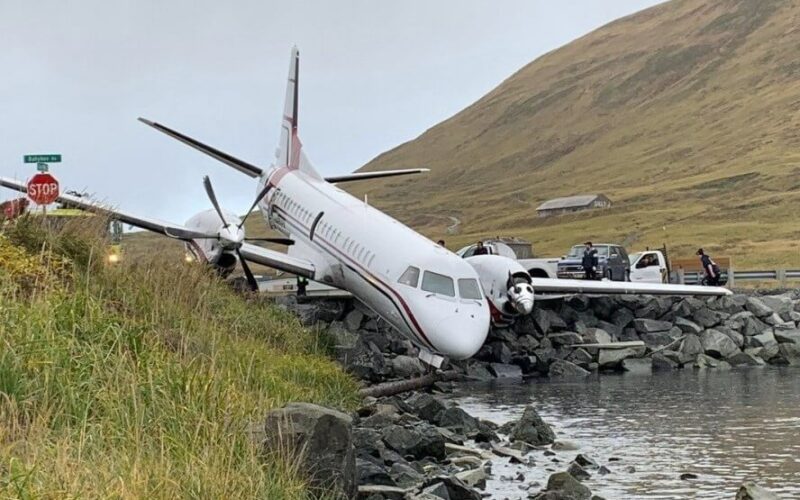Incorrectly wired anti-skid sensors were behind the fatal runway overrun of a Saab 2000 turboprop aircraft in Alaska in 2019, accident investigators have disclosed.
The Peninsula Aviation Service flight, PenAir3296, overran the end of runway 13 at Unalaska Airport (DUT) on October 17, 2019. It crashed through the airport perimeter fence, crossed a road and came to rest on rocks on the shoreline of Dutch Harbor.
The aircraft was carrying three crew and 39 passengers. One passenger sustained fatal injuries and another passenger was seriously injured. Eight passengers sustained minor injuries, mostly during the evacuation, the National Transportation Safety Board (NTSB) said on November 2, 2021.
The accident occurred on the aircraft’s second approach to runway 13. The crew carried out a go-around on the first attempt and then entered the traffic pattern for a second attempt. Despite being told shortly before landing that the wind was coming from 300 degrees at 24 knots, which would have meant a significant tailwind, the crew continued for a landing.
Landing into a headwind is the preferred option because a tailwind increases the distance required to stop.
NTSB investigators said they calculated the aircraft experienced a 15 knot tailwind upon landing, which was above the manufacturer’s limit, and meant the plane landed with a higher groundspeed than normal.
ZERO BRAKING ACTION
Upon landing, the captain said the braking action was normal at first but then reduced to zero.
Investigators found that sensors for the anti-skid system had been incorrectly wired during maintenance work on the left main landing gear. As a result, one tire skidded and burst and brake pressure was released on two of the remaining three wheels. That meant a loss of effective braking, preventing the crew from stopping the plane on the runway.
Other factors contributed to the crash, investigators said, including the crew’s decision to land with a tailwind. They also highlighted that the design of the wires involved did not sufficiently consider or protect against human error during maintenance.
In addition, investigators said the Federal Aviation Administration failed to recognise that the runway safety area, which the accident plane also overran, did not meet the recommended safety criteria for an aircraft like the Saab 2000.
“Even though the airplane, the pilot, the weather and federal oversight all had a role in this tragedy, it was entirely preventable,” NTSB Chair Jennifer Homendy said in a press release. “The brake system should have been designed to protect against human error during maintenance, the pilot shouldn’t have landed on a runway with such a strong tailwind and federal regulators should have considered the runway safety area dimensions when authorizing the airline to fly the Saab 2000 into that airport.”
The final report will be released in a few weeks, the NTSB said.

